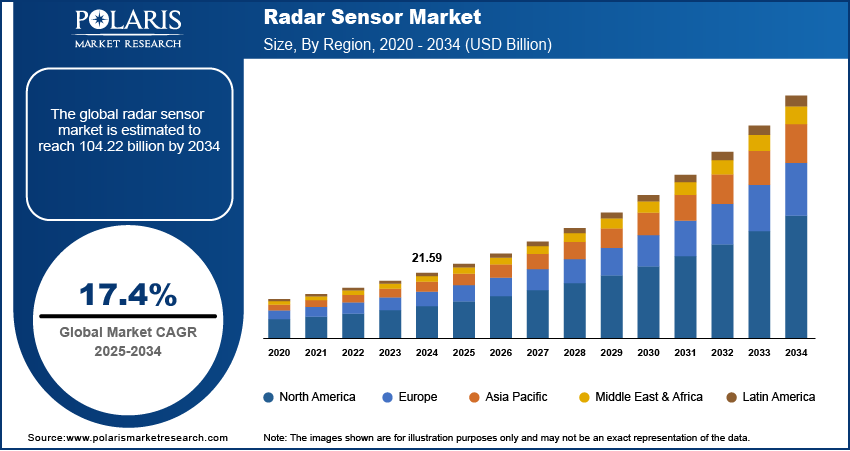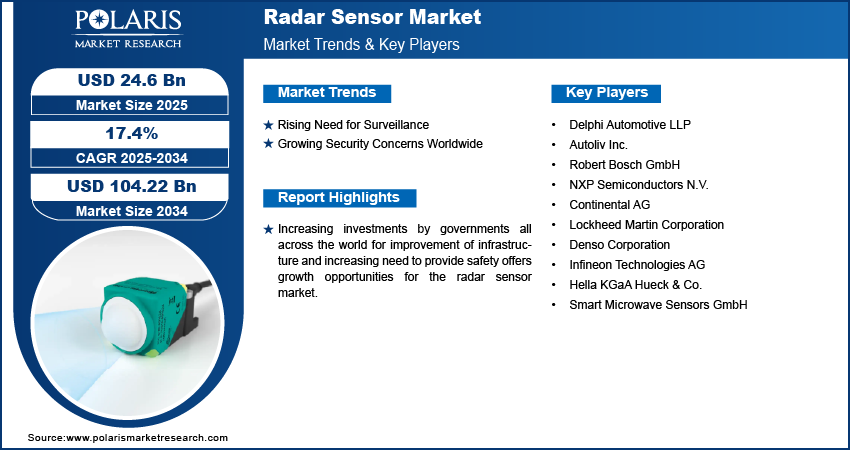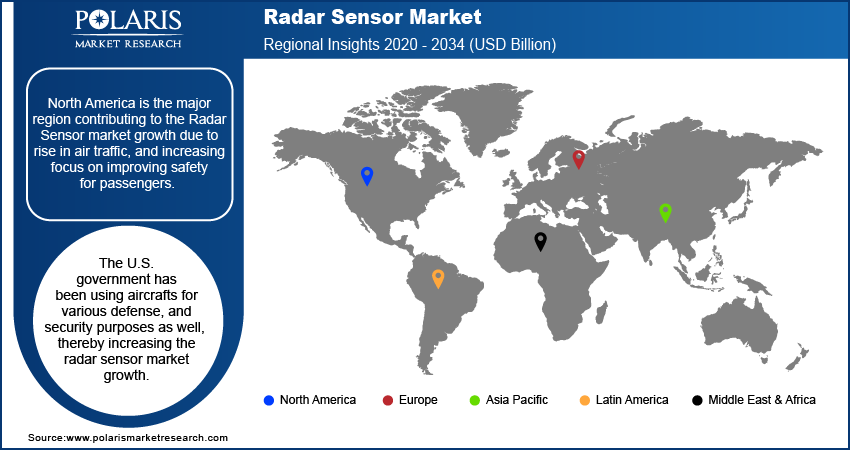
Radar Sensor Market By Type (Imaging Radar Sensor, Non-Imaging Radar Sensor) By Range (Short-Range Radar Sensor, Medium-Range Radar Sensor, Long-Range Radar Sensor) By Component (Transmitter, Receiver, Processor, Antenna, Video Amplifier) By End-User (Aerospace & Defense, Automotive, Security & Surveillance, Industrial), By Regions, Segments & Forecast, 2025 - 2034
- Published Date:Apr-2025
- Pages: 160
- Format: PDF
- Report ID: PM1553
- Base Year: 2024
- Historical Data: 2020-2023
The global radar sensor market size was valued at USD 21.59 billion in 2024. The market is anticipated to grow from USD 24.6 billion in 2025 to USD 104.22 billion by 2034, exhibiting a CAGR of 17.4% from 2025 to 2034.
This market is experiencing significant growth, driven by the increasing demand for radar sensors in the automotive industry. Over the forecast period, the radar sensor market is expected to expand, fueled by the adoption of advanced radar technologies such as millimeter-wave radar and 4D imaging radar. The automotive sector is particularly focused on the integration of radar sensors for applications like adaptive cruise control and collision avoidance. In this context, short-range radar sensors and long-range radar sensors are becoming essential components in modern vehicles.
It is estimated that prominent market players are investing heavily in research and development to enhance radar sensor technologies and provide innovative radar solutions. The imaging radar sensor segment is projected to dominate the market, with non-imaging radar solutions capturing significant market share. As market dynamics evolve, the growth of the radar sensor industry is expected to be propelled by the increasing demand for safety features in vehicles, thereby contributing to the overall radar sensor market size.

Radar sensors are essential components in various applications, especially in the automotive sector, where they are widely used for safety and autonomous driving features. A typical radar system employs different types of radar technologies, such as pulse radar, continuous wave radar, and wave radar, to detect and analyze surrounding objects. It is estimated that the global radar sensors market size will propel attributed to the increasing adoption of radar sensors in the automotive industry.
Key market drivers include the demand for high-performance radar systems and advancements in sensor technology, such as software-defined radar and 4D imaging radar sensors. The market analysis suggests that the medium-range radar sensor segment will significantly drive the market, leading to a strong market forecast for the coming years. The deployment of radar sensors in security applications further enhances the market demand, positioning these technologies as a major player in the global market expansion.
The radar sensor market is crucial due to its extensive applications across various sectors, particularly in the automotive industry. As the demand for advanced radar technologies rises, radar sensors are increasingly used in features such as adaptive cruise control and collision avoidance systems. This trend is driven by the need for radar sensors to enhance vehicle safety and automation. Major players in the market are focusing on developing sophisticated radar processors that can efficiently handle complex data, thus creating a significant impact on market trends. An analysis of the market indicates that the market size is expected to grow substantially as manufacturers integrate high-performance radar transceivers into vehicles.
The growth of radar technology is evident as radar sensors play a pivotal role in the evolution of the automotive sector. The market is segmented based on application, with radar sensor applications ranging from driver assistance systems to autonomous vehicles. This diversification highlights the driving demand for radar solutions across various automotive segments. Companies that lead the market are innovating to meet the demand for advanced radar systems, ensuring their strong position in the market as the industry continues to evolve.
Radar sensors have undergone significant evolution over the years, particularly in the context of the automotive industry. Initially, radar sensors are used primarily for military applications, but advancements in technology have allowed them to transition into the automotive sector. Today, automotive radar plays a crucial role in enhancing vehicle safety and enabling advanced driver-assistance systems (ADAS). As a result, radar sensors are becoming integral to modern vehicles, providing features such as adaptive cruise control and collision avoidance.
In terms of performance, modern radar sensors integrate a high-performance radar transceiver that enhances detection capabilities and accuracy. The major market for these devices is expanding. As consumer awareness and demand for safety features increase, the market is expected to grow significantly, making radar sensors a pivotal component in the future of automotive technology. Radar sensors offer manufacturers and consumers alike improved safety and driving experiences.
What is the Current Size of the Radar Sensor Market?
The current size of the radar sensor market is experiencing significant growth, driven largely by advancements in technology and increasing demand for safety features in vehicles. Radar sensors are devices that play a crucial role in various applications, particularly in the automotive sector, where they enhance functionalities such as adaptive cruise control and collision avoidance systems.
Leading companies such as Robert Bosch GmbH are at the forefront of this growing market, innovating and expanding their product lines to meet the needs of modern vehicles. As automakers prioritize the integration of advanced driver-assistance systems (ADAS), the adoption of sensors in the automotive sector is expected to surge, further propelling the market's growth.
Overall, the radar sensor market is poised for a robust expansion, reflecting the increasing reliance on technology to improve safety and efficiency in transportation.
Which Regions Hold the Largest Market Share?
The global market landscape is dominated by several key regions, each contributing significantly to the overall market share. Among them, North America stands out as a leader, driven by technological advancements and substantial investments from major companies.
In addition to North America, Europe remains a crucial player in the market, with countries like Germany and France leading the charge. Meanwhile, Asia-Pacific is rapidly emerging as a formidable contender, characterized by its expanding manufacturing capabilities and a growing consumer base. This dynamic shift indicates a potential reallocation of market share, with companies keenly eyeing opportunities to enhance its footprint in this region.
What Factors are Driving Market Growth?
Several factors are contributing to the growth of the market, notably the increasing demand for innovative technology solutions. This drive for innovation is spurred by the rapid digitization of industries, leading to enhanced efficiency and productivity. Additionally, the growing emphasis on sustainability and eco-friendly practices is pushing businesses to adopt greener technologies, further fueling market expansion.
Moreover, the rise in disposable incomes and changing consumer preferences are also significant drivers. As people are willing to invest in high-quality products, companies are capitalizing on this trend by offering premium solutions. Furthermore, the global shift towards automation and smart technologies is creating new opportunities, allowing market players to explore untapped segments and expand their reach. Overall, these factors collectively contribute to a robust market growth trajectory.

Radar Sensor Market Scope
By Type |
By Range |
By Component |
By End-User |
By Region |
|
|
|
|
|
What are the Major Types of Radar Sensors?
Radar sensors play a crucial role in various applications, ranging from automotive to aerospace. The major types of radar sensors include Doppler radar, which measures the velocity of objects, and pulse radar, which provides distance measurements by sending out short bursts of radio waves. Another significant type is phased array radar, allowing for electronic steering of the radar beam, making it highly versatile and efficient. In the automotive market, major companies are leading the development of advanced radar systems for adaptive cruise control and collision avoidance, enhancing vehicle safety and automation. Additionally, synthetic aperture radar (SAR) is employed in remote sensing, offering high-resolution images of the Earth’s surface. As the demand for innovative radar technologies grows, these various types of radar sensors continue to evolve, driving advancements across multiple industries.
How Do Different Industries Utilize Radar Sensors?
Radar sensors have become an integral part of various industries, leveraging their ability to detect and track objects in diverse environments. Radar sensors are essential in modern vehicles, primarily for advanced driver-assistance systems (ADAS). They enable features such as adaptive cruise control, collision avoidance, and blind-spot detection. By emitting radio waves and analyzing the reflected signals, these sensors can accurately gauge the distance and speed of nearby vehicles and obstacles, enhancing safety and improving the overall driving experience.
In aerospace, radar sensors are critical for air traffic control, surveillance, and navigation. They help in tracking aircraft, monitoring flight paths, and ensuring safe distances between planes. In defense applications, radar is used for missile guidance, target acquisition, and battlefield surveillance, providing real-time data that can be crucial for strategic operations. Radar technology plays a vital role in maritime navigation, helping ships detect other vessels, landmasses, and potential hazards in the water. This is particularly important in low-visibility conditions, such as fog or heavy rain. Additionally, radar systems are used for weather monitoring and tracking marine traffic, enhancing safety and operational efficiency.
In telecommunications, radar sensors are employed for various applications, including the management of wireless communication networks. They can help in identifying interference, monitoring signal strength, and optimizing network performance. By analyzing the radar signals, companies can improve their service delivery and enhance user experiences. Radar sensors are used in manufacturing for monitoring production lines and ensuring quality control. They can detect the presence and position of objects, facilitating automation processes such as robotic assembly and material handling. This leads to increased efficiency, reduced waste, and improved safety in industrial environments.
Meteorologists utilize radar technology to monitor atmospheric conditions and predict weather patterns. Weather radar systems can detect precipitation, storm systems, and wind patterns by analyzing the return signals from raindrops and other particles in the air. This information is critical for issuing warnings and informing the public about severe weather events. In agriculture, radar sensors are increasingly being used for precision farming. They can help monitor crop health, assess soil conditions, and manage irrigation systems. By providing detailed insights into the agricultural landscape, farmers can make informed decisions that enhance yield and resource management.
Radar sensors are also applied in construction and civil engineering for site monitoring, detecting underground utilities, and assessing structural integrity. Ground-penetrating radar (GPR) is particularly useful for identifying subsurface materials and ensuring that construction projects are executed safely and effectively.
What are the Emerging Applications of Radar Sensors?
In addition to automotive applications, radar sensors are gaining traction within the smart cities. They are being deployed for traffic monitoring and management, providing real-time data on vehicle flow and congestion levels. This information can be utilized to optimize traffic signals and improve urban infrastructure, ultimately leading to more efficient transportation networks. Furthermore, radar technology is being explored for applications in environmental monitoring, such as detecting and tracking weather patterns or assessing changes in land use.
Another innovative use of radar sensors is in the field of healthcare. For instance, non-contact vital sign monitoring systems are being developed using radar technology, allowing for the remote tracking of patients' heart rates and respiration without the need for physical contact. This application is particularly relevant in scenarios where hygiene is paramount, such as in hospitals or during pandemics.
What is the Projected Growth Rate for the Radar Sensor Market?
The radar sensor market is poised for significant growth in the coming years, driven by advancements in technology and increasing demand across various industries. According to Polaris Market Research, the projected growth rate for the radar sensor market is expected to grow at a compound annual growth rate (CAGR) of 17.4% over the forecast period. This growth can be attributed to the rising adoption of radar sensors in sectors such as automotive, aerospace, defense, and industrial automation. As the demand for enhanced safety and operational efficiency continues to rise, the integration of radar sensors in these applications is becoming increasingly prevalent.
Furthermore, the automotive industry, in particular, is a major contributor to this growth trajectory. The implementation of advanced driver-assistance systems (ADAS) and the development of autonomous vehicles are creating a substantial demand for radar sensors. These sensors are essential for functions such as collision avoidance, adaptive cruise control, and parking assistance, thereby enhancing vehicle safety and performance. In addition, the ongoing development of smart cities and infrastructure is further propelling the need for radar technology in applications like traffic monitoring and surveillance.
Moreover, the growing emphasis on Industry 4.0 and the Internet of Things (IoT) is also driving the demand for radar sensors in industrial applications. These sensors enable real-time monitoring and data collection, which are crucial for optimizing processes and improving overall productivity. As industries continue to embrace automation and digital transformation, the radar sensor market is expected to flourish, offering innovative solutions that meet the evolving needs of various sectors. With such promising projections, stakeholders in the radar sensor market are likely to invest heavily, ensuring continuous innovation and expansion in this dynamic field.
Who are the Key Players in the Radar Sensor Market?
The leading players in the Radar Sensor market include Denso Corporation, Infineon Technologies, Robert Bosch GmbH, Continental, NXP Semiconductors, Texas Instruments, Hella, Analog Devices, Lockheed Martin, STMicroelectronics, , ZF Friedrichshafen, Honeywell International, Inc., Banner Engineering Corp., Emerson, Hitachi, Northrop Grumman, Qualcomm Technologies, RTX Corporation, Delphi Automotive, and Aptiv
What Strategies are Leading Companies Using to Gain Market Share?
Leading companies are increasingly adopting a variety of strategies to gain market share in today's competitive landscape. One prominent approach is the investment in innovation. By continually developing new products and enhancing existing ones, companies can meet evolving consumer demands and differentiate themselves from competitors. For instance, tech giants often allocate substantial resources to research and development, enabling them to introduce groundbreaking technologies that capture consumer interest and loyalty.
Moreover, strategic partnerships and collaborations are becoming increasingly prevalent. Companies are joining forces with other businesses, influencers, or even non-profits to expand their market presence and enhance credibility. These alliances can provide access to new customer segments and leverage shared resources for mutual benefit, effectively enhancing market penetration.

How Does the Competitive Landscape Vary by Region?
Understanding how the competitive landscape varies by region is crucial for businesses aiming to expand or optimize their operations globally. In North America, for instance, the market is characterized by high levels of innovation and significant investment in technology. Companies often compete fiercely on the basis of product quality and customer service, with an emphasis on brand loyalty. This results in a landscape where businesses must continually evolve to maintain their market position.
Conversely, in regions like Southeast Asia, the competitive landscape can be influenced by a rapidly growing middle class and increasing digital penetration. Here, companies may focus on affordability and accessibility, as price sensitivity is a key factor for many consumers. Additionally, local players often have the advantage of understanding regional nuances and cultural preferences, making it essential for foreign businesses to adapt their strategies accordingly.
In Europe, the competitive landscape is shaped by stringent regulations and a strong emphasis on sustainability. Companies are increasingly competing on their environmental impact and compliance with various directives, which can create both challenges and opportunities. The focus on sustainability also opens avenues for innovation, as businesses seek to develop eco-friendly products that align with consumer values.

What are the Key Takeaways from the Radar Sensor Market Report?
The Radar Sensor Market Report reveals several critical insights that are shaping the future of this rapidly evolving industry. One of the most significant takeaways is the projected growth trajectory of the market, driven by increasing demand across various sectors, including automotive, aerospace, and defense. This growth is primarily fueled by the rising adoption of Advanced Driver Assistance Systems (ADAS) in vehicles and the growing need for precise monitoring and detection capabilities in military and civil applications.
Additionally, technological advancements are playing a crucial role in enhancing radar sensor performance. Innovations in millimeter-wave radar technology and phased array systems are improving accuracy, range, and resolution, making these sensors more effective for diverse applications. The report also highlights the importance of miniaturization, as smaller sensors can be integrated into a wider range of devices, from drones to smartphones, thus broadening the market's scope.
Furthermore, the report emphasizes the increasing focus on smart cities and IoT applications, where radar sensors are vital for traffic management, environmental monitoring, and security systems. The integration of radar technology with other sensing modalities, such as Lidar and camera systems, is also becoming a trend, enabling more comprehensive data collection and analysis.
Lastly, regional analysis indicates that North America currently leads the market, driven by significant investments in R&D and technological adoption. However, the Asia-Pacific region is expected to witness the fastest growth, supported by rising industrialization and urbanization. Overall, the Radar Sensor Market Report provides a comprehensive overview of current trends, technological advancements, and market dynamics that stakeholders must consider for strategic planning and investment
FAQ's
The radar sensor market size is valued at USD21.59 billion in 2024 and is projected to grow at a CAGR of 17.4% over the forecast period. The increasing demand for advanced radar technologies, particularly in the automotive industry, is driving this growth.
Several factors are contributing to the growth of the radar sensor market. Firstly, the increasing demand for safety features in vehicles is leading to a surge in the adoption of automotive radar systems. Additionally, advancements in radar technologies, such as 4D imaging radar and millimeter-wave radar, are enhancing the capabilities of radar sensors. Furthermore, the expansion of the automotive sector and the rising need for automation and smart technologies in vehicles are also driving market growth.
Radar sensors are utilized in various applications across different industries. In the automotive sector, they are primarily used for advanced driver-assistance systems (ADAS), including adaptive cruise control, collision avoidance, and parking assistance. Outside of automotive applications, radar sensors are employed in aerospace for air traffic control, in maritime for navigation, and in industrial settings for level measurement and monitoring.
The market share of radar sensors varies significantly across regions due to differences in technological adoption and regulatory frameworks. North America, particularly the United States, holds a significant share of the global radar sensors industry, driven by the presence of major automotive manufacturers and technology companies. Europe also has a substantial market share, thanks to stringent safety regulations and a strong automotive industry. Meanwhile, the Asia-Pacific region is witnessing rapid growth due to increasing investments in automotive technologies and rising consumer demand.
